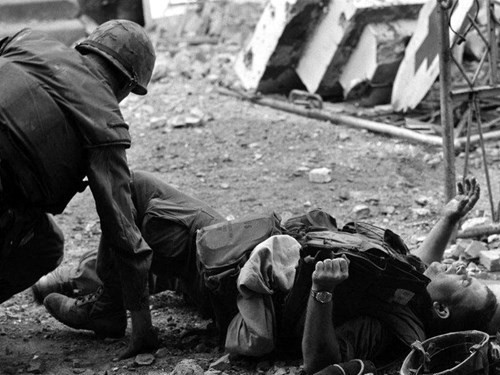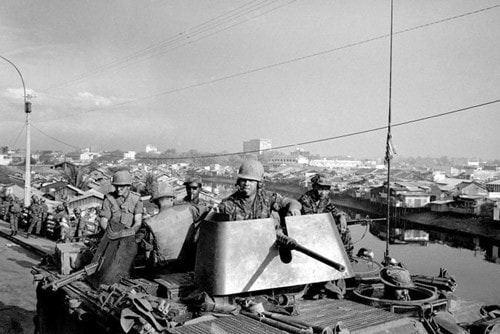The 1968 Tet Offensive: A valuable lesson for the Americans
Author Kenneth T. Walsh in his latest work on the 1968 Mau Than Campaign believes that the 1968 Mau Than Spring General Offensive and Uprising left valuable lessons for the US.
In a recent article in US News titled “50 Years Later, the Tet Offensive in Vietnam Still Resonates”, author Kenneth T. Walsh argued that the 1968 Tet Offensive left valuable lessons for the US. The People’s Army Newspaper introduces the main content of the article:
The 1968 Tet Offensive and Uprising began in the early morning of January 30, 1968. Tens of thousands of North Vietnamese and Viet Cong soldiers coordinated a series of surprise attacks on more than 100 cities, towns, and American bases in South Vietnam, stunning both American and South Vietnamese soldiers right on the occasion of the Tet New Year.
|
| US Marines wounded in battle at Hue in 1968. Photo: AP |
The lessons of the 1968 Tet Offensive still resonate. “The 1968 Tet Offensive shaped the world we live in today. In it, the American public still does not have complete confidence that government officials will accurately inform the people about external developments. They also do not have faith that the leaders will act correctly,” Princeton University historian Julian E. Zelizer commented.
One of the most shameful events for America was the enemy's daring attack onUS Embassy in Saigon. American television channels all broadcast sharp images of this attack, surprising American and world public opinion. Another event that must be mentioned is the enemy's capture of Hue city and fierce fighting that lasted for three weeks.
Before the Tet Offensive of 1968, US President Lyndon Johnson and General William Westmoreland, Commander-in-Chief of the US Army in Vietnam, declared that victory was at hand. By mid-February 1968, about two weeks after the Tet Offensive broke out, 2,000 South Vietnamese soldiers and 1,000 US soldiers had been killed while the number of wounded reached 12,000, half of whom were US soldiers. This number of casualties continued to increase until the Tet Offensive ended at the end of February 1968.
After the Tet Offensive in 1968, many Americans realized that the statements of President Lyndon Johnson and General William Westmoreland were wrong. General William Westmoreland himself indirectly admitted that when he proposed to add 200,000 troops to continue the war.The General Offensive and Uprising of the Spring of Mau Than 1968was heavily reported by American media.
One of the most brutal images that haunted public opinion was the AP photo of General Nguyen Ngoc Loan, Director General of the National Police of the Republic of Vietnam, shooting a Viet Cong soldier in the head with his hands tied on the street. The American people realized that America could not win this war and it was time to withdraw from Vietnam. The anti-war movement in the US began to grow.
|
| American and puppet soldiers in Saigon in 1968. Photo: AP |
Assessing the 1968 Mau Than General Offensive and Uprising, CBS announcer Walter Cronkite declared on television: “One thing is more certain than ever: the bloody war in Vietnam is falling into a stalemate.
To say that we are close to victory would be to ignore the evidence and believe in mistaken optimists.”
By March 1968, a Harris Poll showed that only 26% of Americans approved of President Lyndon Johnson's handling of the Vietnam War, down from 34% in November 1967. "The 1968 Tet Offensive showed that President Lyndon Johnson and General William Westmoreland were lying about "moving toward a critical point where the end begins to dawn" as the American general had declared.
In addition to the damage caused to President Lyndon Johnson's reputation, the unexpected 1968 Tet Offensive and Uprising, which exposed the US government's boasting about a prospect of victory, dealt a painful blow to public confidence in the US government," historian Julian E. Zelizer commented.
Another lesson is that the 1968 Mau Than General Offensive and Uprising showed that no matter how much the US had superiority in military and war technology, a determined and courageous opponent always knew how to find ways to win battles and convince American public opinion against the war.
50 years ago, through the Tet Offensive in 1968, millions of Americans realized that the enemy was willing to sacrifice for the independence of their country and was capable of inflicting heavy casualties on the US military. This weakened the fighting spirit of the US side.
The Vietnam War has haunted the Pentagon for decades. America’s wars in Iraq and Afghanistan—the longest war in American history—show that history can repeat itself. Today, the enemies are more diverse and dispersed, both outside and inside the United States. The threats are real. Meanwhile, America’s power is limited, as was clearly demonstrated in the Tet Offensive of 1968 half a century ago.




